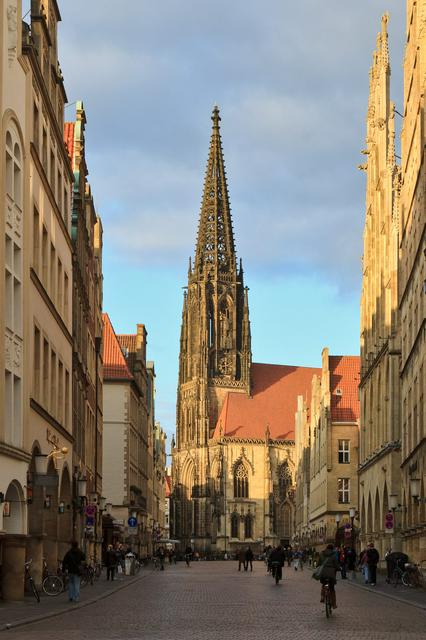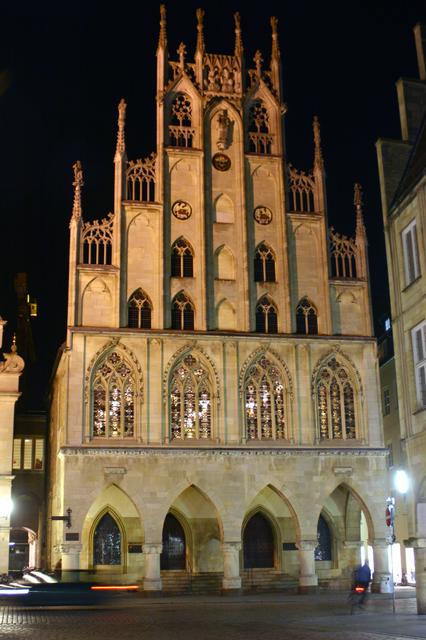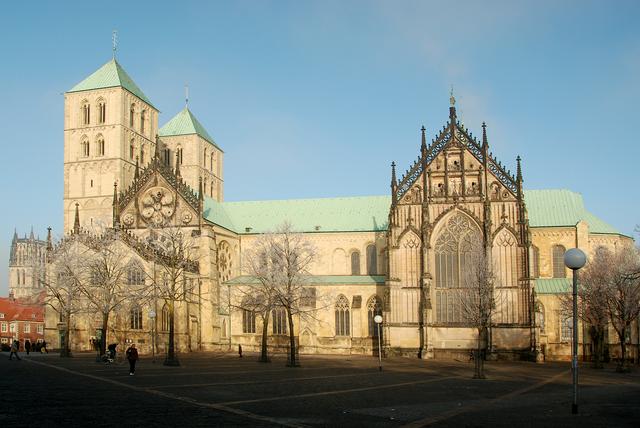 Münster is a city in North Rhine-Westphalia, in the northwest of Germany.
Münster is a city in North Rhine-Westphalia, in the northwest of Germany.
Münster was founded as a monastery in 794 by the Frisian missionary Saint Liudger to aid Charlemagne's campaign to gain control over the Saxons. The city's name is derived from the word "monastery" which can be seen from its Latin name of Monasterium. In 805, Münster was made a bishopric and, in 1170, it obtained its town rights.
For centuries the city and its surrounding (the Münsterland) was ruled by powerful prince-bishops who were religious leader, political ruler and supreme judge at the same time. During the Middle Ages, Münster was a member of the Hanseatic League, becoming a prosperous trade city; the proud patrician houses on Prinzipalmarkt give evidence of this era. In 1534 and 1535, Münster was ruled by the radical Protestant sect of Anabaptists led by the Dutch preacher Jan van Leiden who crowned himself priest-king of the "Kingdom of Zion", expecting an imminent end of the world. The movement was brutally suppressed by the Catholic Church and their leaders tortured, executed and put into cages that were hung on the city's highest steeple (the cages can still be seen hanging on the St Lamberti Church's tower).
-ByyYr.medium.jpg) In 1648, the Westphalian Peace treaty was negotiated and signed coevally in Osnabrück and at the Rathaus (city hall) of Münster (envoys of the different parties were constantly riding between the two cities back and forth), marking an end to the Thirty Years' War. This peace treaty gave rise to the modern concept of state sovereignty which is known as the "Westphalian order" among international law scholars. The city is proud of this heritage, claiming the slogan of being "the city of Peace".
In 1648, the Westphalian Peace treaty was negotiated and signed coevally in Osnabrück and at the Rathaus (city hall) of Münster (envoys of the different parties were constantly riding between the two cities back and forth), marking an end to the Thirty Years' War. This peace treaty gave rise to the modern concept of state sovereignty which is known as the "Westphalian order" among international law scholars. The city is proud of this heritage, claiming the slogan of being "the city of Peace".
In 1815, the Prince-Bishopric of Münster was annexed by Prussia and Münster became the capital of the Prussian province of Westphalia. Since then, it has been dominated by administrative and judicial institutions, professional services and trade, while industry never played a big role. The city has long had a reputation of being deeply "black", i.e. Catholic and conservative (while most cities in North Rhine-Westphalia were dominated by the working class and were considered strongholds of socialism and thus "red").
Münster University was founded in 1773, but it was closed down by the Prussian government in favour of the newly-founded University of Bonn. It was however re-established by German Emperor William II in 1902 who also confered his name to it (Westfälische Wilhelms-Universität). Since then, the number of students has massively grown. Nowadays, the University and the Münster polytechnic (Fachhochschule) have about 50,000 students in total—a significant share of them being international students—who have given the city a much more liberal and diverse outlook, contrary to its traditional image.
Since Westphalia was merged into the state of North Rhine-Westphalia, Münster has lost its capital role to Düsseldorf, but the city of just over 300,000 inhabitants still hosts several administrative institutions, courts of justice, insurance and trade companies and, first and foremost, educational institutes. It is home to high-tech startups. To many Germans, Münster is a household name because the popular crime series Tatort which is regularly watched by more than a third of the German TV audience has a number of episodes set here known for their tongue in cheek humor (unusual for Tatort otherwise) and the "unlikely couple" of Prof. Karl Friedrich Boerne, a coroner, and Frank Thiel a carless bike-driving cop with a hippie father. While much of the episodes is actually shot elsewhere, popular landmarks still feature prominently in many episodes.
 Almost all the interesting sites are concentrated in the city centre, which is easily walkable.
Almost all the interesting sites are concentrated in the city centre, which is easily walkable.
- Peace Hall. Located in the old city hall, is famous for the signing of the historic Treaty of Münster, a document which, as a part of the Peace of Westphalia, ended the Thirty Years' War and established the Westphalian style of diplomacy between sovereign states.
- Prinzipalmarkt. The Prinzipalmarkt used to be the city's main market street. It was heavily bombed during the Second World War, but unlike elsewhere, where ruins gave way to faceless blocks of concrete, the houses were rebuilt, some following the original plans and some merely inspired by the old architecture. Try to spot to houses with identical gables (hint: there aren't any, but they're all pretty). Today it is home to many of the city's more exclusive (some might say posh) shopping establishments.

- St. Paul's Cathedral, Domplatz 28. Münster is known for its vast number of churches that dot its entire cityscape, including gothic St. Lambert's (Lambertikirche) and Baroque St. Clement's Church (Klemenskirche). The city's most impressive church, the St. Paul's Cathedral, is well worth a visit.
-MdInv.medium.jpg)
- Palace. It was finished in 1787 as one of the last major high-Baroque buildings in Germany (by that time Rococo and even Neoclassicist styles had already become in vogue), designed by Johann Conrad Schlaun, Münster's leading Baroque architect. Unfortunately, Prince-Bishop Maximilian Friedrich, who had commissioned the building, never got to move in there, having died three years earlier. His successor didn't bother much, and shortly thereafter Münster lost its status of prince-bishopric and the palace was used for other purposes. These days it is home to the university administration. During World War II, it was heavily damaged. The exterior was entirely rebuilt in the original style while the interior rather reflects the preferences of the 1950s. There's little to look at inside (although doors are open during university hours), but its façade is a curious and very characteristic combination of sandstone and red brick. During summer, lots of events are held on the square, somewhat marring the view more days than not.
- Behind the palace, surrounded by a pentagonal moat, are the extensive palace grounds, occupied by a tranquil landscape garden and the University's Botanical gardens. daily 08:00–16:00, longer hours in summer. You don't need to be a biologist to enjoy a lengthy stroll along the paths lined by some 8,000 different species. When the weather turns ghastly (it often does), you can seek refuge in ten greenhouses and pretend it's summer. Free.
- Haus Rüschhaus. Late-Baroque country house, former residence of the poet Annette von Droste-Hülshoff, beautiful and well-maintained Baroque garden.
- City Museum, Salzstraße 28, +49 251 492 45 03. Tu–F 10:00–18:00, Sa Su 11:00–18:00, M closed. If you're curious how the city evolved from the tiny hamlet of Mimigernaford it was in the 6th century to become the bike-infested metropolis of today, the City Museum holds the answers. Even though the exhibits are exclusively in German, many speak for themselves, and admission is free.
- Picasso Museum, Picassoplatz 1, +49 251 414 471 0. Tu–Su 10:00–18:00, M closed. The only museum devoted exclusively to the graphic works of Pablo Picasso. Has varying exhibits on Picasso and his life, but also his contemporaries and friends, and holds almost all of his lithographical works. Adults €10, children (6-16) €4, students €8.
City Museum, Salzstraße 28, +49 251 492 45 03. Tu–F 10:00–18:00, Sa Su 11:00–18:00, M closed. If you're curious how the city evolved from the tiny hamlet of Mimigernaford it was in the 6th century to become the bike-infested metropolis of today, the City Museum holds the answers. Even though the exhibits are exclusively in German, many speak for themselves, and admission is free.
Picasso Museum, Picassoplatz 1, +49 251 414 471 0. Tu–Su 10:00–18:00, M closed. The only museum devoted exclusively to the graphic works of Pablo Picasso. Has varying exhibits on Picasso and his life, but also his contemporaries and friends, and holds almost all of his lithographical works. Adults €10, children (6-16) €4, students €8.
Peace Hall. Located in the old city hall, is famous for the signing of the historic Treaty of Münster, a document which, as a part of the Peace of Westphalia, ended the Thirty Years' War and established the Westphalian style of diplomacy between sovereign states.
Prinzipalmarkt. The Prinzipalmarkt used to be the city's main market street. It was heavily bombed during the Second World War, but unlike elsewhere, where ruins gave way to faceless blocks of concrete, the houses were rebuilt, some following the original plans and some merely inspired by the old architecture. Try to spot to houses with identical gables (hint: there aren't any, but they're all pretty). Today it is home to many of the city's more exclusive (some might say posh) shopping establishments.
St. Paul's Cathedral, Domplatz 28. Münster is known for its vast number of churches that dot its entire cityscape, including gothic St. Lambert's (Lambertikirche) and Baroque St. Clement's Church (Klemenskirche). The city's most impressive church, the St. Paul's Cathedral, is well worth a visit.
Palace. It was finished in 1787 as one of the last major high-Baroque buildings in Germany (by that time Rococo and even Neoclassicist styles had already become in vogue), designed by Johann Conrad Schlaun, Münster's leading Baroque architect. Unfortunately, Prince-Bishop Maximilian Friedrich, who had commissioned the building, never got to move in there, having died three years earlier. His successor didn't bother much, and shortly thereafter Münster lost its status of prince-bishopric and the palace was used for other purposes. These days it is home to the university administration. During World War II, it was heavily damaged. The exterior was entirely rebuilt in the original style while the interior rather reflects the preferences of the 1950s. There's little to look at inside (although doors are open during university hours), but its façade is a curious and very characteristic combination of sandstone and red brick. During summer, lots of events are held on the square, somewhat marring the view more days than not.
Behind the palace, surrounded by a pentagonal moat, are the extensive palace grounds, occupied by a tranquil landscape garden and the University's Botanical gardens. daily 08:00–16:00, longer hours in summer. You don't need to be a biologist to enjoy a lengthy stroll along the paths lined by some 8,000 different species. When the weather turns ghastly (it often does), you can seek refuge in ten greenhouses and pretend it's summer. Free.
Haus Rüschhaus. Late-Baroque country house, former residence of the poet Annette von Droste-Hülshoff, beautiful and well-maintained Baroque garden.
- Zoo. There is an all-weather zoo in Münster.
- Swimming. There is a nice modern indoor swimming pool near the town centre.
Zoo. There is an all-weather zoo in Münster.
Swimming. There is a nice modern indoor swimming pool near the town centre.
Prinzipalmarkt, the main shopping district hosts mostly expensive brand-name fashion and jewelry stores.
There is a huge choice of restaurants in Münster. The cuisine of almost every country in the world is represented.
- Mocca d' or, Rothenburg 14. a nice choice for Italian food
- Stuhlmacher, Prinzipalmarkt 6 (by the Town Hall/Rathaus, +49 251 44877.
- Kiepenkerl. has tables outside by the Maypole
Mocca d' or, Rothenburg 14. a nice choice for Italian food
Stuhlmacher, Prinzipalmarkt 6 (by the Town Hall/Rathaus, +49 251 44877.
Kiepenkerl. has tables outside by the Maypole
Münster has a large student population so there are a range of bars such as Cafe Extrablatt and Markt Cafe (on the market square by the Cathedral). The Jüdefelder Straße (located north west of the city centre) gathers many bars and pubs such as Gorilla, Die Rote Liebe, Davidswache, Destille and more. Alternatively, you can find a huge amount of bars in the "Hafen" area (south east of the city centre, behind the main train station). Prices are usually reasonable (starting at around €2 for a beer and €4/5 for a cocktail).
- Pinkus Müller. Take advantage from being in Münster by drinking an Altbier at Brauerei und Altbierküche Pinkus Müller. The Pinkus Müller restaurant and bar has its own brewery producing some really tasty beers.
- Markt Cafe. A modern bar and café opposite the cathedral
- Stuhlmacher. A traditional pub next to the Rathaus (town hall) on Prinzipalmarkt
- Café Garbo, Warendorfer Straße 45-47 (east of the center, +49 251-30300. 10:90-01:30. A cafe-pub which offers good, fresh food, mostly vegetarian or vegan. A lot of fair trade and ecological products as coffee, tea, jucies, vegetables. Sandwiches for breakfast, great house-made cake, Dutch and English menue (German menue also for blind people available!). Free-wlan, changing table, a lot of newspapers, nice, warm and cosy atmosphere, also meeting point for LGBT. Since it's also a cinema you can always view a movie before or after dinner. Most movies are in German, but some are in their original languages with German subtitles. Mains €4-9.
Pinkus Müller. Take advantage from being in Münster by drinking an Altbier at Brauerei und Altbierküche Pinkus Müller. The Pinkus Müller restaurant and bar has its own brewery producing some really tasty beers.
Markt Cafe. A modern bar and café opposite the cathedral
Stuhlmacher. A traditional pub next to the Rathaus (town hall) on Prinzipalmarkt
Café Garbo, Warendorfer Straße 45-47 (east of the center, +49 251-30300. 10:90-01:30. A cafe-pub which offers good, fresh food, mostly vegetarian or vegan. A lot of fair trade and ecological products as coffee, tea, jucies, vegetables. Sandwiches for breakfast, great house-made cake, Dutch and English menue (German menue also for blind people available!). Free-wlan, changing table, a lot of newspapers, nice, warm and cosy atmosphere, also meeting point for LGBT. Since it's also a cinema you can always view a movie before or after dinner. Most movies are in German, but some are in their original languages with German subtitles. Mains €4-9.
- Burg Hülshoff, Schonebeck 6, 48329 Havixbeck (about 12 km west of the city centre; on the D3 cycle path from Münster to Havixbeck. Romantic, late-medieval water castle owned by the noble family Droste-Hülshoff (whose most well-known offspring was the poet Annette von Droste-Hülshoff).
- Telgte. Lovely and peaceful old town; the octagonal Baroque St Mary's Chapel is Northern Germany's most important Catholic pilgrimage destination. Moreover there is a museum of religious traditions, a brandy distillery museum, several historic (Renaissance or Baroque) buildings, and a number of small restaurants and shops.
Burg Hülshoff, Schonebeck 6, 48329 Havixbeck (about 12 km west of the city centre; on the D3 cycle path from Münster to Havixbeck. Romantic, late-medieval water castle owned by the noble family Droste-Hülshoff (whose most well-known offspring was the poet Annette von Droste-Hülshoff).
Telgte. Lovely and peaceful old town; the octagonal Baroque St Mary's Chapel is Northern Germany's most important Catholic pilgrimage destination. Moreover there is a museum of religious traditions, a brandy distillery museum, several historic (Renaissance or Baroque) buildings, and a number of small restaurants and shops.
- Lüdinghausen, small town with three castles, including the beautiful Vischering water castle, 30 km south, best accessible by bike along the scenic "Route of hundred castles"
- Dülmen, mostly rebuilt after World War II, but has a number of historical sights and an extensive English-style landscape garden, 30 km southwest, 20 minutes by half-hourly regional express
- Hamm, transportation hub, has one of the biggest and most impressive Hindu temples in Germany, 40 km south, 25 minutes by half-hourly regional train
- Rheine, 1000-year old saline, medieval monastery, churches and royal manor, 45 km north, 25 minutes by hourly regional express
- Osnabrück, the other city of the Westphalian Peace, 55 km northeast, 35 minutes by hourly regional train, or by bike along the "Peace route"
- Recklinghausen, in the northern Ruhr district, unlike most cities in Northwest Germany it was hardly damaged during World War II, therefore has a well-preserved old town core, 60 km southwest, 40 minutes by half-hourly regional express
- Dortmund, big trade and industrial city on the Ruhr steeped in history and famous for its football (soccer) team, 65 km south, 30 minutes by intercity or 55 minutes by regional train
- Enschede, Münster's twin city in the Netherlands, 65 km northwest, 1 hr 20 min by hourly regional train
